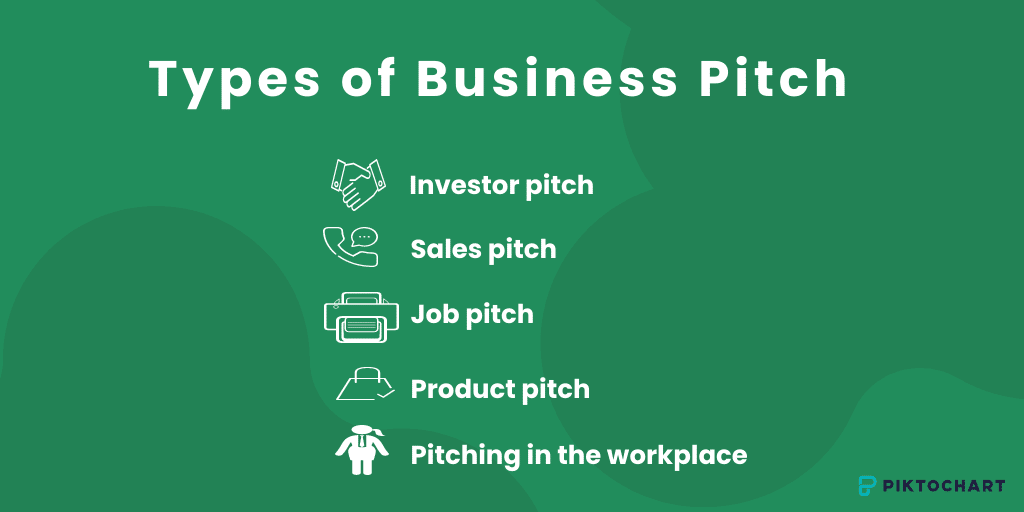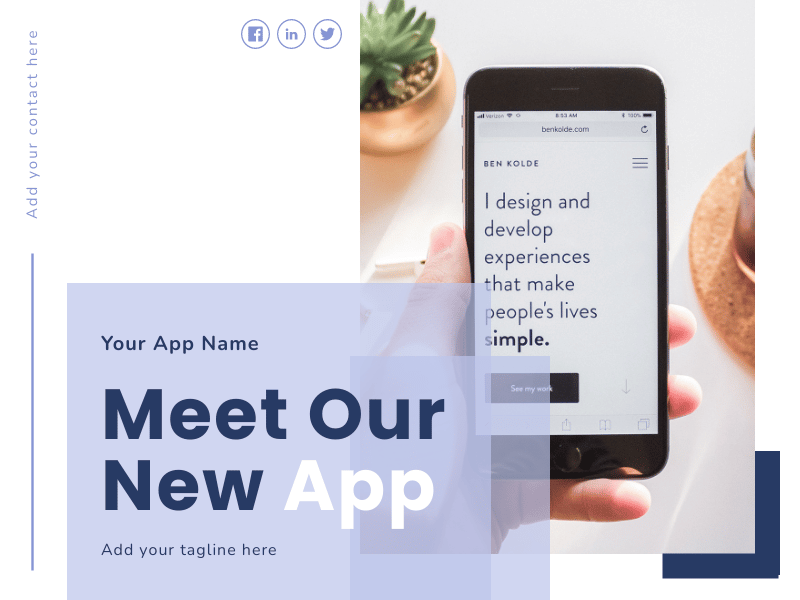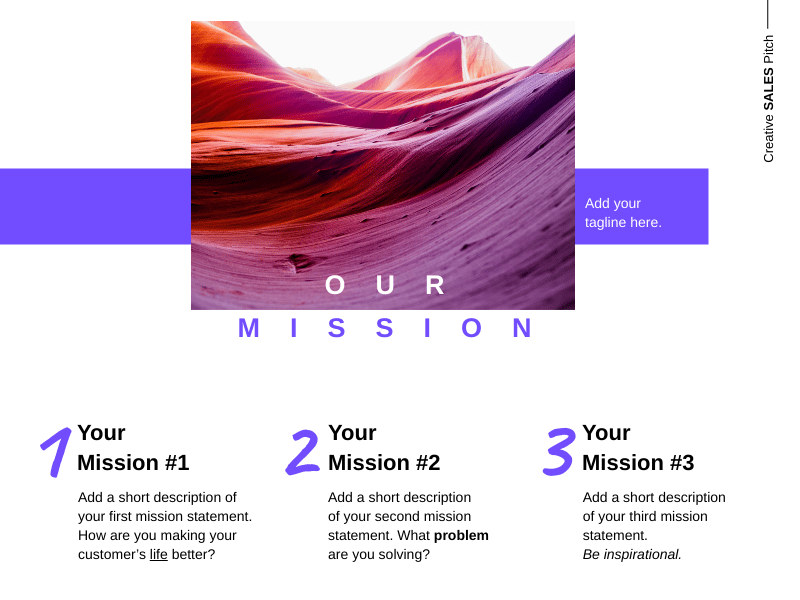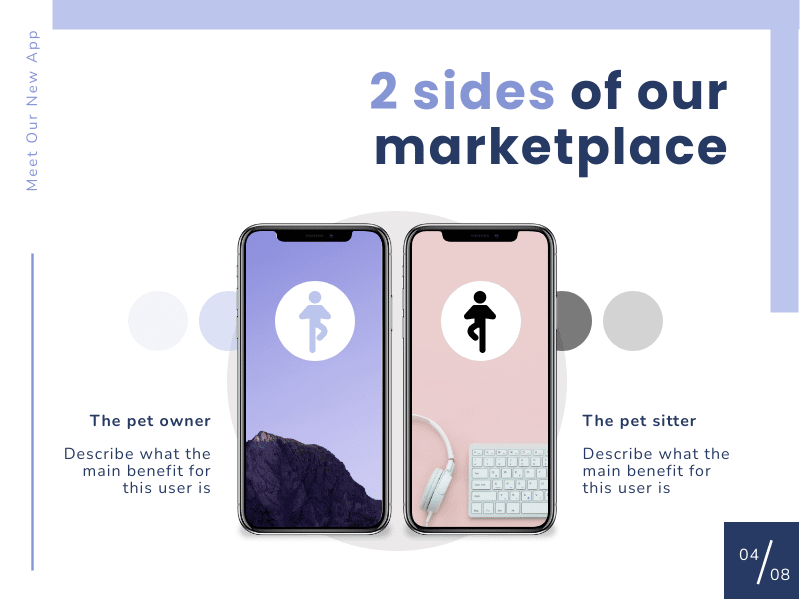You’ve just had your lunch, and you’re about to get back to work.
While making your post-lunch tea (or coffee), you can’t stop thinking about being your own boss.
You wonder if it’s about time for you to turn your side hustle into a full-time business and become an entrepreneur.
Or perhaps you want to propose the idea of a four-day workweek to your CEO.
If you want to introduce investors and prospects to your business idea and convince them to take the plunge with you, you need a strong and persuasive business pitch.
How to create a persuasive business pitch according to experts
The good news — it’s possible to craft a convincing and successful business pitch.
Even better news: This Piktochart business pitch guide shows you how.
Grab your drink of choice and take notes as we explore the different ways to pitch business ideas (from a sales-style elevator pitch to an innovative workplace pitch), as well as understand what makes a great business pitch.
You’ll also get a glimpse into our business pitch templates, and learn expert advice from those who have pitched their way to success (and failure too).
Want to hop into the fast lane and get started? Let us give you a headstart with our AI presentation maker. You can share what type of slide deck you want to create, pick from dozens of appropriate gorgeous templates, then tweak the most suitable one in our editor. In minutes, you’ll have a slide deck ready to go.
To get the most out of your editing and to make your business pitch stellar, we recommend checking out the rest of the article!
You can also watch the video below if you don’t have time to go over this guide. It’s also easier to follow along if you sign up for a free Piktochart account and edit the templates yourself (learning by doing).
What is a business pitch?
A business pitch is a presentation of a business idea to a group of people who can help turn your idea into a reality.
You can pitch to:
- Investors who can help fund your idea
- Potential customers who will pay for your product or service
- Advocates who will support your idea
In some cases, a business pitch doesn’t have to be all about presenting a new idea. You could be asking for more funding or continued support for an already established business venture.
Whether through an investment, purchase, or advocacy, a business pitch becomes successful if you can convince people to believe in your idea or pique their interest and get them to learn more.
Now that you understand what a business pitch is, let’s take a closer look at the different types of business pitches.
Types of pitches in business
Your business pitch can be narrowed down to the following five types of presentations:
1. Investor pitch
In this type of business pitch, you present a persuasive presentation or pitch deck to a group of potential business partners and/or investors.
Sign up for a free Piktochart account to get started on creating professional-looking pitch deck templates that you can edit in minutes.
An investor business pitch should typically last for 45 minutes. The best practice for this type of pitch is 20-30 minutes of presentation followed by discussion or a Q&A afterward.
Alternatively, business pitch competitions follow a different best practice. These presentations should last around five to 10 minutes and focus on pitching to investors.
Lastly, the most stringent type of business pitch is most commonly referred to as an ‘elevator pitch’, and should only last around 30-60 seconds.
Let’s dive in so you can learn how to make the perfect pitch for your business!
2. Sales pitch
The goal of a sales pitch is to answer the question “What’s in it for me?” from the lens of the potential customer.
The best and most effective salespeople can make a sales pitch in as short as one minute. Also known as the ‘elevator pitch‘, this type of business pitch should be able to be delivered in a single elevator ride (30-60 seconds on average). In this format, a short sales pitch should include four key components:
- Your unique product name and category
- The specific problem you are trying to solve
- The innovative solution you offer
- the unique selling point of benefit to your solution
3. Product pitch

A product pitch is similar to a sales pitch, however, the spotlight should be on the product and/or solution itself.
For example, a sales pitch for an email automation software will highlight one or two of its benefits. Meanwhile, a product pitch of the same automation software will focus more on its features, how it works, and how you can integrate the software into your existing setup.
In a product pitch, you should aim to:
- Explain your product or offering clearly and concisely
- Identify and address the target audience and/or industry your product supports
- Specify the problem the aforementioned faces and how your solution can solve it
- Provide a realistic example of your solution in action
- Make sure to use accurate facts backed up by relevant and recent data
4. Job pitch

If you’re applying for a job or internship and you’re wondering how you can stand out from the crowd (consisting of your peers and other qualified applicants), consider pitching yourself to a prospective employer.
Applying the same logic used for a sales or product pitch deck; sell yourself!
A great pitch for a potential job opportunity or personal summary pitch should be concise, personalized, and consistent. In a job pitch you should include:
- A brief introduction to you
- An explanation as to why you’re a great fit for the company and role
- Relevant experience and achievements
- Your goals and career aspirations
“It’s not about bragging or showing off — it’s about giving the other person evidence that you can actually do what you say you can do,” assures Starla Sampaco, TV news anchor at KCTS 9 and founder of Career Survival Guide.
5. Workplace pitching
Do you have an idea or initiative that will help your colleagues and help boost the company’s profitability? Pitch it internally within your workplace, to your team or boss!
For example, you can pitch a remote-first culture or the four-day workweek to your HR, and/or the rest of the leadership team.
Another workplace pitch example? Maybe you might want to propose the creation of a new role in your team which can help advance your career and address a challenge in the organization at the same time.
To do this, simply create a pitch deck including your main points, the benefits, and proposed next steps to turn your idea into a reality. Piktochart’s workplace pitch decks can help you get your point across through our workplace templates.
The structure of a successful business pitch
If creating a business pitch sounds intimidating, the team at Piktochart has your back.
You can address this worry by making sure that you have a business pitch structure that is sure to succeed, using our tips & templates.
When you have a formulated pitch deck structure, template, and agenda, you’ll know exactly what you’re going to say next, taking the bulk of the stress out of presenting.
Additionally, these best practice presentation structures make your business pitch more memorable to your audience and leave a lasting impression. Statistically, it turns out that people retain structured information up to 40 percent more accurately than information presented in freeform.
The WHAC Method
Whether you’re pitching to a group of potential investors or you’re selling real estate, use the WHAC method when structuring your perfect business pitch.
The WHAC method is introduced in The 3 Minute Rule by Brandt Pividic, an award-winning film director and television producer. He wrote the book to detail his experience and tips as he made hundreds of pitches in Hollywood.
This well-known WHAC method stands for:
What is it and what do you offer?
You start your business pitch by answering the questions: what is it, and what do you offer? This information is often found in the executive summary of business plan templates.
At this point, you share your business plan and quickly outline the problem and solution you offer. For example, let’s say that you want to pitch the idea of having a UX researcher on your product team.
You list down existing problems and challenges that your team and/or organization are currently experiencing without a dedicated UX researcher. Afterward, you propose your solution — hiring someone who can step in and do user research.
How does it work?
Next, explain your proposal. Provide a quick summary of the benefits of your solution. In our example, share how the UX researcher will help the product team accomplish its objectives.
It can be tricky explaining how your business idea works. Figuring out how to deliver this information in an entertaining and simple manner can turn potential investors into partners, as we’ve seen from some of the best startup pitch decks.
Since you don’t have much time and attention spans are short, the key is to boil down how your idea works into a few key points. Explain how it works from a high-level overview and weave this in as part of your compelling story.
Are you sure?
Once you have provided the solution, the people listening to your elevator pitch are likely saying to themselves, “will it really work?”
This is the point where you have to provide solid proof in your pitch. You can use testimonials, a short case study, or statistics.
You should also mention financial projections in order to leave a positive impression. If your manager or potential investors will provide funding for your idea, they’ll want to know what the ROI is.
Can you do it?
The final part of your pitch should answer this question.
Now that your audience has heard you talk about the problem, solution, and proof that it works, you need to show them how you’re going to implement the solution. Think of this point as the “actionable” part of your pitch. You can even provide steps to break down how this can be achieved in a certain timeframe.
“Show how you have thought about how to turn your idea into a commercial outcome or true partnership. This is really an opportunity to start or continue building trust and showing that you care about creating real value for the people in the room is the best way to put you on the right foot,” shares Michael Rosenbaum, CEO of Spacer, one of the biggest parking marketplaces in the U.S.
Like any good sales pitch, you need to show how achievable the results are. At this particular stage, you need to tie in any additional information to show what resources or specific and unique skills are required to make it happen.
Being transparent about what’s required can build trust with potential investors.
How to persuade your audience with your business pitch
Now that you know the best practice structure of a successful business pitch, take note of the following tips to help make your business pitch more interesting, relatable, and most of all, convince your audience to say “yes”.
1. Understand what your audience wants from you
It’s standard advice across all facets of industry to “know your audience”.
However, if you’d like to become better at your business pitches, go the extra mile by understanding what your audience wants from you.
There’s a difference between understanding and knowing your audience. Instead of just knowing where your client comes from, try to understand their pain points, goals, and motivation.
How do you do this?
Talk to them in advance, read about the things they publish online (tweets, blog posts), and understand what excites them. By doing so, you’ll be able to tailor your business pitch to their needs, wants, and preferences.
For example, if you’re pitching to potential clients and investors who are eco-conscious at the same time, it makes sense to highlight how your idea can positively impact the environment.
Stephen Keighery, CEO of Home Buyer Louisiana and Founder of Bald Eagle Investments USA, shares this tip when it comes to customizing your pitch to your audience:
“Learn ahead and research about the company or the client you’ll be pitching to, just be sure that every information you obtain is for public knowledge. You can also observe their behavior and their words during the transaction; and perhaps while pitching, use the jargon they use to establish connection and a favorable impression to them.”
2. Have your elevator pitch ready
Imagine this. You just bumped into Mark Cuban of Shark Tank at the airport lounge, and you can’t believe that you’re sitting next to him! He looks at you and asks you about yourself and what you do.
This is when you need your elevator pitch handy!
The Asana team recommends the following elements of a good elevator pitch:
- Introduction
- Problem
- Solution
- Value proposition
- CTA (call to action)
You don’t have to follow the exact formula. You can mix it up based on the situation, your personality, and the audience you’re pitching to.
It’s also worth noting that you might not immediately notice the benefit of your elevator pitch. Think of it as an opportunity for you to make a great first impression.
3. Use visual aids
If you have the chance to present beyond the elevator pitch, you should never pitch with a presentation that’s filled with texts, numbers, or endless rows of data.
As humans, our brains are hardwired to love visuals — from photographs to infographics to icons.
When pitching an idea, product, or service, get your audience’s attention (and support!) by telling a story visually and adding a bit of creativity to your PowerPoint slides.
Images trigger empathy which in turn can make your audience understand your pitch better.
The more they understand your idea, the greater the likelihood of angel investors, venture capitalists, and potential customers supporting or advocating for you.
Another added benefit is that visuals can elicit emotions and emotions play an important role in decision-making.
Consider incorporating business infographics to present complex data or processes in an easily digestible format.
Watch these 10 legendary pitch decks for visual inspiration.
4. Explain your business model clearly

When pitching to investors, imagine them asking, “what’s in it for me?”.
After learning about how your idea can help solve a problem, they’re interested in how you’re going to advertise to your target market and generate revenue consistently.
Johannes Larsson, CEO of Financer.com explains that being able to articulate their business model was what made them successful in getting business partners on board.
“We were relatively unknown in the industry, so it took us quite a few tries before we signed our first deal. After that, however, things became much easier — not just because we were building up a name for ourselves but also because we improved our approach.
We learned that being able to clearly explain our business model was the key to earning potential partners’ trust. Once we mastered that, we focused on providing proof of fruitful partnerships. It was obvious that this information was what our affiliates cared about, so we made sure to gather evidence of our success and present it in every pitch.”
5. Weave your passion or story with your pitch
Your business pitch doesn’t have to sound like you’re reading it straight from a script that someone else wrote for you.
When appropriate, add a bit of your personal touch. In short, humanize your pitch and slide deck.
It will not only improve your relatability factor but also make you feel less nervous. After all, you’re talking about something that you’re passionate about.
Take it from Debbie Chew, an SEO Specialist at Dialpad.
“As part of my hiring process, I had to pitch a marketing campaign idea. I started brainstorming a list of potential ideas and their projected impact to decide which one to go with.
While doing this, one idea kept coming back to me, and I realized I was most passionate about pitching a campaign related to video meetings. People now spend so much of their time in video meetings, but how much time? And how can we have better meetings? So I built my pitch around this concept and really enjoyed pitching my idea (which also helped me feel less nervous),” shares Chew.
If you can share a personal story or something you’re passionate about in your pitch — while also tying it back to your audience — they won’t forget it. And yes, I got the job!”
6. Put the spotlight on benefits
Once you have your audience’s attention, circle back to how your product or service will address customer needs and benefit business partners.
For Carsten Schaefer of Trust.io, it boils down to being able to share the benefits of your product or service from the get-go.
“When I first had to get funding for my product, I had to deliver a sales pitch in front of a board of investors. It didn’t succeed, and I learned a lot from it.
“Investors want cold, hard facts and the benefits to the end-user. In the end, they want to see if it makes money for them or not. I’m glad I failed because I learned that for an effective sales pitch, you really need to put yourself in the shoes of someone thinking about profit and pure common sense from a business perspective.
Create a successful business pitch
Select a template that sparks your imagination. Clone, add or delete blocks. Visualize concepts, processes, lists, timelines and data. Use charts and graphs. Sync them with spreadsheets. Export the visual in PDF or PNG format. Start for free.
Create a visual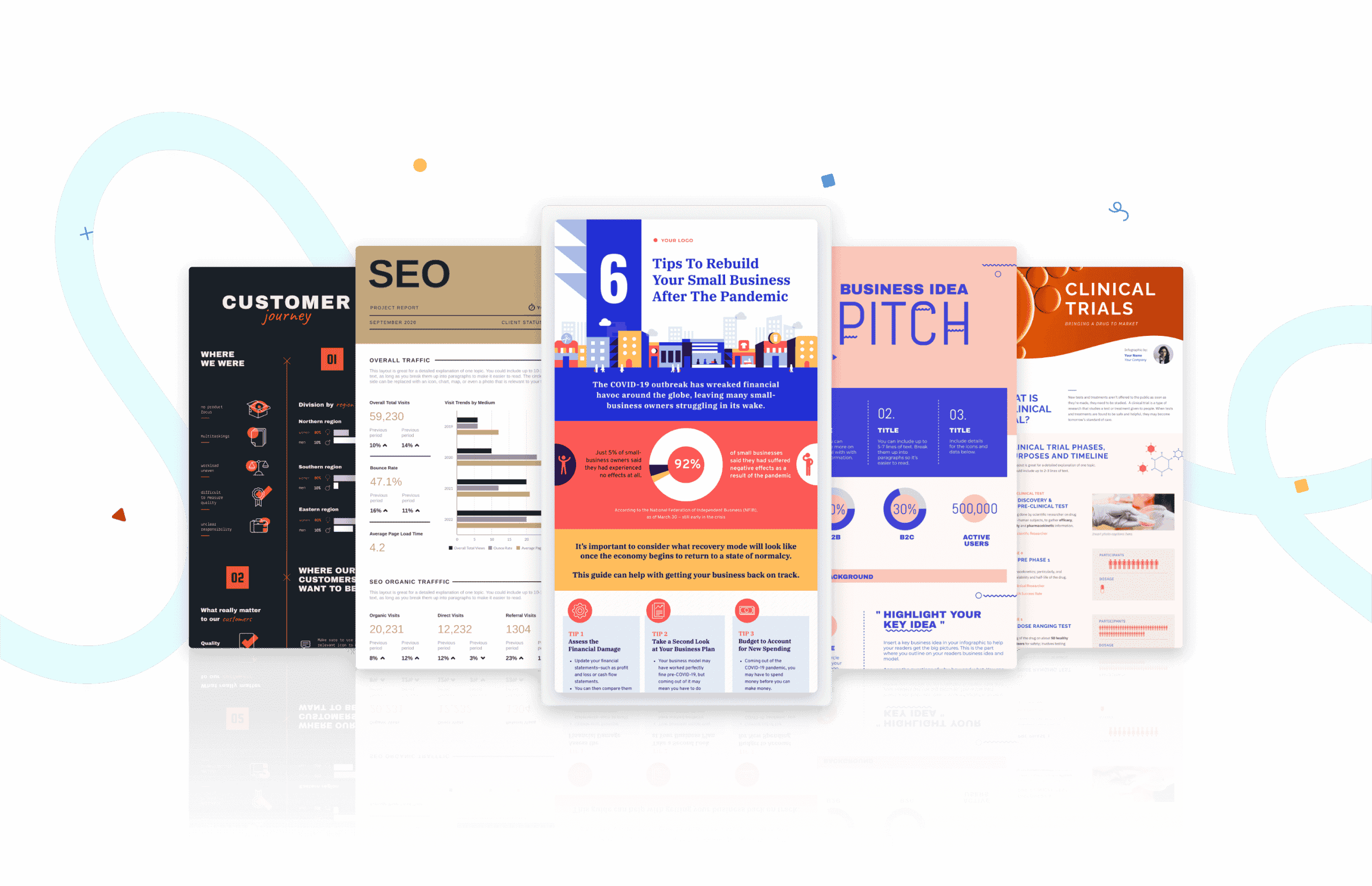
7. Highlight why you’re different from the competition

Your business pitch is also an opportunity for you to explain what sets you apart from other businesses or organizations, and essentially explain your unique selling point. What makes your idea different? Why is your business model unique?
It also helps to address relevant competition head-on in your pitch. For Brogan Renshaw of Firewire Digital, this tactic shows clients and investors that you’re an expert on what you are talking about, giving them confidence in your offering.
“I notice that this is a part of my business pitches that completely wins the client over because it answers their questions and concerns on the market position of competitors,” says Renshaw.
8. Share the story behind your team

Investors and business partners are also curious about the people, employees, as well as the team behind your idea. When creating this presentation slide in your pitch deck, don’t forget to include information highlighting your team and each team member’s relevant skills.
“Investors want to know whether the founders have worked together before, if your startup’s early hires have complementary skill sets, and whether you’ll be flexible, open-minded, and willing to embrace different perspectives, “ writes Lauren Landry, associate director of marketing and communications for Harvard Business School Online.
9. Have an impressive one-pager
As its name implies, a one-pager is a one-page document outlining your business plan and mission. Think of it as a business brochure. With Piktochart’s online brochure maker, you can easily create one within minutes.
Imagine that an investor or client is too busy to listen to your pitch, you can simply email or hand out your one-pager; your entire business pitch in an easy-to-digest format.
According to Greg Cullen, Sr. Account Executive at Dialpad, your one-pager should have these three components:
- What is the business pain?
- How the solution you’re positioning can solve said business pain
- The value of the solution accompanied by the resulting positive impact by moving forward with the platform
“This one-pager condenses everything that is important succinctly into an easy-to-digest easy to digest format for everyone to read – and it ensures that all parties are on the same page. And most importantly, this can be used by the champion you’re working with to sell this internally, whether it’s to the CEO, procurement, etc. The better you make this one-pager, the better the result you’ll have,” recommends Cullen.
Get funding, win clients, and gain support with Piktochart’s pitch deck creator
While it may be nerve-wracking, particularly if it’s the first time that you’re creating a business pitch, use the expert tips above as your guideposts for a successful pitch.
You’ll eventually find your very own unique style and approach to business pitching as you do it more frequently.
If you need help creating any type of business or personal pitch deck, create your pitch deck quickly with Piktochart’s pitch deck creator. The first step is to get your free Piktochart account.
Want additional insight on how to better prepare and deliver a business pitch that you’ll be presenting online? Go to our guide to stress-free, engaging Zoom presentations.
We’re rooting for you and your business!

